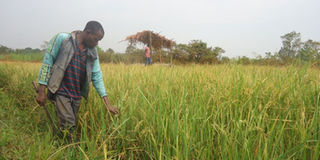Political situation, weather condition affect rice price trends

More smallholder farmers are growing rice, which is projected to help achieve self-sufficiency in production. FILE PHOTO
Rice has become an important cash and food crop in Uganda over the last couple of years. This is evident in Iganga and Bugiri districts in the east, Hoima and Kabarole districts in the west, Amuru and Nwoya districts in the north, among others.
Between 2002 and 2012, rice production grew by 77 per cent (from 120,000 to 212,000 tonnes), mainly due to favourable policies, the development of improved seeds and the high level of prices in the domestic market which constitute a strong incentive for farmers.
The Common External Tariffs (CET) within the Eastern African Community is an agreement which allows the taxation of imported rice up to 75 per cent.
This measure was put in place in order to limit the level of importation of rice and to promote self-sufficiency in production.
Priority crop
Moreover, rice is among the 15 strategic agricultural commodities that have been selected by ministry of Agriculture for prioritisation in the Development Strategy and Investment Plan (DSIP) owing to its high returns to investment and huge potential.
Although Uganda’s production has increased significantly, it is unable to satisfy the increasing demand from urban consumers, which is closely linked with rapid urbanisation and economic growth. For example, in 2013 Uganda’s broken rice imports amounted to around $7m (Shs23.2b) in value
Rice (Kayiso)
Since 2010 to date, the value of Kayiso rice has increased gradually making a difference of Shs850 (30.1 per cent) per kilogramme on retail and Shs770 (30.1 per cent increase) per kilogramme on whole sale.
During the first half of the year 2011, Kayiso rice recorded the highest increase in the prices in the past five years with 32.6 per cent on retail and 36.2 per cent on wholesale between the months January to June 2011.
This was followed by prices in October 2011-May 2012 period, which increased by 23.8 per cent on retail and 23.8 per cent on wholesale.
The big increase in the prices was attributed to inflation rate, which affected the fuel prices hence increase in the transport costs that directly led to an increase in the price.
The increase was due to low harvest caused by drought that hit the country in the first quarter, which destroyed most of the food crops.
Hence, people turned most of demands to rice especially kayiso, which is a low-priced rice in the market due to its quality in terms of size and scent.
The other reason for the price fluctuation during the months of January and February is due to opening of the school term.
This is when most schools buy in bulk and stock for the pupils/students; and affects the prices of Kayiso because most of the schools prefer it because of its lower price compared to Super and Pakistan.
Rice prices do not fluctuate much in the market simply because competition from other rice types that are preferred highly than Kayiso due to the attributes—grain size, brokenness, sweetness, and easiness to cook.
Rice (Super)
Super rice (Uganda) as the name suggests is the premium brand recognised nationally and across East African region. All the varieties of rice have the same trend pattern across the years indicating a possible correlation between their prices. Like it happened with Kayiso rice, the highest price of Super rice was recorded in May 2012.
The wholesale and retail prices increased rapidly from February 2011-May 2012.
The hike in the prices was brought by the dry spell that occurred from December 2010 to February 2011—it affected the prices of the most commodities and more so the general inflation in the country, which was brought about by the political situation (general elections).
The inflation rates in Uganda, like any African country, tend to go high during the political campaign years and this affects the prices highly. As a result of the above factors, the price increased by 46 per cent retail and 47.6 per cent on wholesale prices respectively.
For rice, like any other crop, the price is affected by other types in the market from different origins such as Super Tanzania and Pakistan rice, IRRI-6 sweet variety (15, 20 and 25 per cent broken), Tilda rice, Basmati, among others.
The beauty with Super rice is that it beats the other types of rice on aroma and taste whereas the other types are preferred for their cleanliness hence easy to cook without any sorting.
Tracking back the average price trends of Super rice in the last three years, shows that the prices have been stable. It has been trading between Shs 3,000-Shs3,400 per kilogramme on retail price and Shs2,630-Shs3,010 making a difference of Shs400 on both retail and wholesale.
From the analysis, one can predict the average price of super rice to be in the range of Shs3,000-Shs3,500 if the conditions remain constant and the inflation reduces.
The author is content and research executive, FIT Uganda




